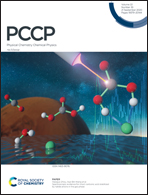Interpreting interfacial semiconductor–liquid capacitive characteristics impacted by surface states: a theoretical and experimental study of CuGaS2†
Abstract
Semiconductor–liquid interfaces are essential to the operation of many energy devices. Crucially, the operational characteristics of such devices are dependent upon both the flat band potential and doping concentration present in their solid-state semiconducting region. Traditionally, capacitive “linear” Mott–Schottky plots have often been utilized to extract these two parameters. However, significant concentrations of surface states within semiconductor–liquid junctions can give rise to strong non-linearities that prevent an effective linearity-based analysis. In this work, we detail a theoretical approach for estimating both the doping concentration and flat band potential from the capacitive characteristics of semiconductor–liquid junctions heavily impacted upon by surface states. Our theoretical approach is applied to CuGaS2 immersed in an aqueous electrolyte, for which excellent convergent values of the doping concentration and flat band potential are obtained across a wide range of impedance measurement frequencies. The results suggest a marked improvement over a linearity-based approach that could assist the analysis of many types of semiconductor–liquid junctions subject to high concentrations of surface states.

- This article is part of the themed collection: 2020 PCCP HOT Articles


 Please wait while we load your content...
Please wait while we load your content...